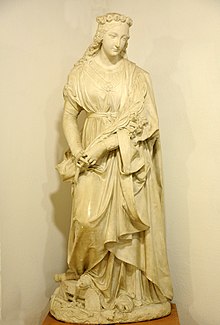
Back القديسة فيلومينا Arabic القديسه فيلومينا ARZ Filomena de Roma Catalan Svatá Filoména Czech Philomena von Rom German Φιλομένα Greek Filomena (santa) Spanish Filomena Basque Philomène (sainte) French פילומנה HE
Philomena | |
|---|---|
 The Triumph of Saint Philomena of Rome | |
| Virgin and martyr | |
| Born | c. 10 January 291 Greece |
| Died | c. 10 August 304 (aged c. 13) Rome, Italy |
| Cause of death | Capital punishment by decapitation |
| Venerated in | Catholic Church[1] Oriental Orthodoxy[2] |
| Major shrine | Sanctuary of Saint Philomena in Mugnano del Cardinale |
| Feast | 11 August (Catholic Church) 10 August / 4 Misra (Coptic Orthodoxy)[3] |
| Attributes | Martyr's palm, crown of both white and red roses, arrows, anchor, sometimes a partially slit throat |
Catholic cult suppressed | 14 February 1961 |

Philomena (/ˌfɪləˈmiːnə/ FIL-ə-MEE-nə), also known as Saint Philomena (Ancient Greek: Ἁγία Φιλουμένη, romanized: Hagía Philouménē; Modern Greek: Αγία Φιλομένα, romanized: Agía Filoména) or Philomena of Rome (c. 10 January 291 – c. 10 August 304) was a virgin martyr whose remains were discovered on May 24–25, 1802, in the Catacomb of Priscilla. Three tiles enclosing the tomb bore an inscription, Pax Tecum Filumena (i.e. "Peace be unto you, Philomena"), that was taken to indicate that her name (in the Latin of the inscription) was Filumena (Ancient Greek: φιλουμένη, romanized: philouménē, lit. 'beloved'), the English form of which is Philomena. Philomena is the patron saint of infants, babies, and youth,[4] and is known as "The Wonderworker".[5]
The remains were moved to Mugnano del Cardinale in 1805. There, they became the focus of widespread devotion; several miracles were credited to Philomena's intercession, including the healing of Pauline Jaricot in 1835, which received wide publicity. John Vianney attributed to her intercession the extraordinary cures that others attributed to him.
From 1837 to 1961, celebration of her feast day was approved for regional calendars, but was never included in the General Roman Calendar. The 1920 typical edition of the Roman Missal included a mention of her, under 11 August, in the section headed Missae pro aliquibus locis ("Masses for some places"), with an indication that the Mass to be used in those places was one from the common of a virgin martyr, without any proper.[6] The Coptic Orthodox Church celebrate the feast of Saint Philomena on 10 August of the Gregorian calendar which is 4 Misra of the Coptic calendar.[7]
- ^ Cite error: The named reference
AASwas invoked but never defined (see the help page). - ^ "الشهيدة فيلومينا | St-Takla.org". st-takla.org. Retrieved 2023-10-11.
- ^ "الشهيدة فيلومينا | St-Takla.org". st-takla.org. Retrieved 2023-10-11.
- ^ "st philomena". Catholic Online. Retrieved 2019-10-03.
- ^ O' Sullivan, Paul (1993). St. Philomena: The Wonder-Worker (8th ed.). Gastonia U.S.A.: TAN. pp. 1–92. ISBN 0895555018.
- ^ 1920 typical edition of the Roman Missal, with feasts updated to the late 1920s Archived 2020-03-01 at the Wayback Machine, p. [214]: "11 August. St Philomena. Virgin and Martyr. Mass: Loquebar from the Common of Virgins, 1."
- ^ "الشهيدة فيلومينا". St-Takla.org. Retrieved 2024-05-27.